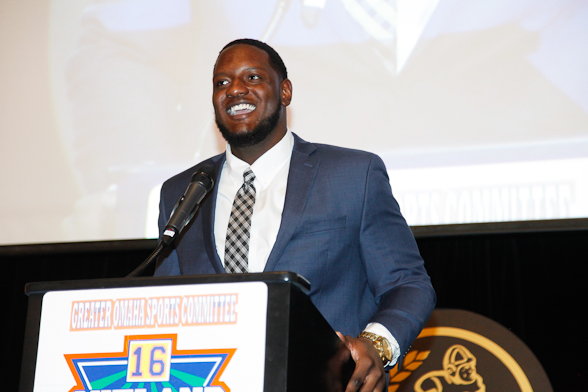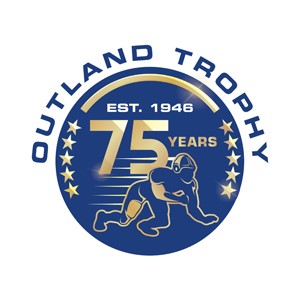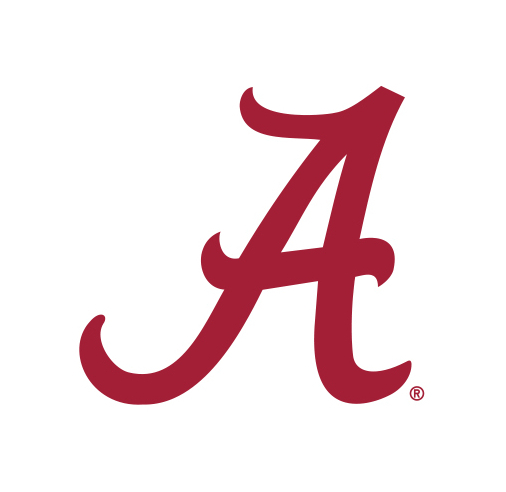This is the 11th in a series on Outland Trophy winners from 2006 to2020. From 1946 to 2005, Outland Trophy winners were profiled in a book by Gene Duffey, Sixty Years of the Outland Trophy. We are catching up with the last 15 winners.
(Offensive tackle Cam Robinson was selected in the second round of the 2017 NFL Draft, 34th overall by the Jacksonville Jaguars. The fourth of six Alabama linemen (all since 1999) to win the Outland Trophy, Robinson has started and played in 47 games for the Jaguars since 2017.)
By Gene Duffey, Author
Pencil spotlight in on the football player. No, not Deshaun Watson, the star of Clemson’s 35-31 victory over Alabama to win the national championship in January 2017. Check out the other player nearby, the hulking guy in white, wearing No. 74.
ESPN’s Tom Rinaldi is interviewing Watson, the Tigers quarterback and star of the evening, who won the game with a touchdown pass to Hunter Renfrow with just two seconds to play.
Suddenly, from off camera, a huge Alabama player appears. Look at the guy. It’s Cam Robinson, the Crimson Tide’s oversized left tackle. Robinson shakes hands with Watson and whispers in his ear.
“I know him fairly well,” Robinson says the next day. “We were in the same recruiting class. I just wanted to congratulate him.”
It was a class move in a tough moment for Robinson. His Alabama team had just lost a chance to win back-to-back national championships by the narrowest of margins. The pain of the defeat will stay with Robinson.
“I have a hard time getting over the losses,” he says. “I think it’s going to linger for a while.”
Robinson didn’t lose very often in his three years at Alabama. He started all 44 games of his college career and lost only four times, twice to Mississippi and twice in the national playoffs. In addition to the Clemson defeat, the other occurred to eventual champion Ohio State in the semifinals as a true freshman.
He followed a long and winding road from West Monroe, Louisiana to claiming the 2016 Outland Trophy.
His first experience with organized football began in a YMCA league at age 7. Next, he moved on to touch football and eventually tackle.
Robinson started out on the defensive side of the ball, playing linebacker and defensive end. “It was fun,” he said.

He didn’t switch to offense until his freshman year at Ouachita High School in Monroe, Louisiana where he began as a left tackle. “The offensive line coach and head coach asked me to move (to offense),” said Robinson. “It was something I was willing to do.”
Robinson began high school at Ouachita, where he played for two years. He transferred to West Monroe High School for his junior year. “I always wanted to go to West Monroe,” he said.
His older sister, Charity, played basketball at Ouachita and their mother, Priscilla, did not want her children to attend different high schools. When Charity went off to McNeese State, Cam transferred to West Monroe.
Cam played a little basketball himself in high school. He played his freshman year at Ouachita and his junior year at West Monroe before giving up the sport. “I wanted to be freer to focus on what I wanted to do,” said Robinson. Translation: Concentrate on football.
Robinson was a familiar name to the coaches at West Monroe before he arrived.
“We knew him since he was a little kid,” said Jerry Arledge, an assistant coach at West Monroe during Robinson’s time there and later the head coach. “His uncles went to school here and his grandparents live about two blocks from our stadium.”
Some people were upset at the school that Robinson left behind. “There were ill feelings from the Ouachita people,” said Arledge, adding that he heard charges of tampering. That means high school football is a very big deal in the area.
Robinson already weighed 325 pounds when he arrived at West Monroe. “He was the biggest kid I’ve ever seen,” said Arledge. “The thing so impressive about Cam is he’s got the greatest feet of any big kid I’ve seen.”
Arledge had inherited some football talent from his father, Steve Foley, who played at Northeast Louisiana. Foley went on to play linebacker for seven seasons in the NFL, five with the Cincinnati Bengals and one each with the Houston Texans and San Diego Chargers.
Cam’s junior year West Monroe reached the state semifinals. The Rebels built a 48-20 lead, then lost 49-48. “I didn’t play defense (in that game),” said Robinson. But the loss still hurt.
West Monroe went 9-3 Robinson’s senior season, losing 14-0 in the second round of the state playoffs to Central High School, near Baton Rouge.
Robinson did play some defensive end in high school when he “was needed.”
In his senior year the website 24/7 Sports rated Robinson the No. 2 prospect in Louisiana behind running back Leonard Fournette, who went on to LSU and became the No. 4 pick by Jacksonville in the 2017 NFL draft.
“You had to fire him up very little,” Arledge of Robinson. “No doubt in our mind (he would be this good). When you’re that size, you’re going to be the No. 1 pick in America.”
Michigan, Auburn and Arkansas joined the hunt for the big guy. Robinson finally narrowed his college choices to Alabama, LSU and Texas. “When I was young I was a huge LSU fan, even in high school,” he said. “When the recruiting process started it’s a different aspect.”
The winning tradition in Tuscaloosa sold him on the Crimson Tide. Alabama won the national championship in 2012, beating Notre Dame for the title, and won its first 11 games in 2013 before losing to Auburn on the infamous missed field goal return. Oklahoma then beat Alabama in the Sugar Bowl.
Robinson committed to Alabama just before the start of his senior year at West Monroe. Naturally, there was some resentment when he announced he would be leaving the state for Alabama, instead of enrolling at LSU.
“The Tigers don’t miss many (in Louisiana),” said Arledge. “(Robinson signing with Alabama) was one of the things that got the LSU offensive line coach fired.”
Robinson was able to graduate from high school in December and enrolled at Alabama for the spring semester.
“It was tough physically and mentally,” Robinson said of his early transition to college football. But he was glad he made the move to college one semester ahead of schedule, benefiting tremendously from spring practice.
“It helped me a lot,” he said. “I got a good grip on the playbook. Football wise, the talent level was much different.”
The left tackle position had been left open when Cyrus Kouandjio, the starter in 2013, left for the NFL. The Buffalo Bills drafted him in the second round in 2014, No. 44 overall.
Robinson handled the new challenge well enough to earn the starting left tackle spot in the spring as a true freshman.
“I was not surprised,” he said. “It was one of my goals. I came in and worked extremely hard.”
Alabama opened the 2014 season, with Robinson in the starting lineup, against West Virginia in the Georgia Dome in front of over 70,000.
“It was completely different from high school,” he said. “I think I played pretty well. I don’t think I gave up any sacks.”
Neither did Alabama. The Tide attack rolled to 538 yards of total offense and beat West Virginia, 33-23.
The Tide went 11-1 that season, losing only to Mississippi by six points in Oxford, then beat Missouri in the SEC Championship Game back in Atlanta. Ohio State stopped the Tide express in the national semifinals en route to the national championship.
Robinson and Alabama reached the summit in college football in 2015, winning the national championship with a pulsating 45-40 win over Clemson in the title game at Glendale, Arizona. “It’s the highest achievement,” said Robinson. “It was an exciting moment, overwhelming really.”
Robinson hit a bump in the road the following May. He was back home on a break before summer school started. He and Hootie Jones, a reserve safety and special teams player at Alabama who was also from Monroe, were arrested late at night in a local park for illegal possession of stolen firearms and possession of a controlled substance in Ouachita Parish.
Police officers smelled marijuana when they approached Robinson’s car. Robinson was seated in the driver’s seat.
Police spotted a handgun on Jones’ lap, who was sitting in the passenger seat. A bag of marijuana was found on the floor. A stolen handgun was also located under Robinson’s seat.
Jones and Robinson were released early the next morning on bonds.
Prosecutors decided not to pursue the case a month later for lack of evidence.
“I used it as a learning experience,” said Robinson.
After initially suspending both players indefinitely, Alabama coach Nick Saban allowed both back on the field for the start of the season. They both completed community service.
Louisiana district attorney Jerry D. Jones expressed sympathy for the Alabama athletes. “I want to emphasize once again that the main reason I’m doing this is that I refuse to ruin the lives of two young men who have spent their adolescence and teenage years, working and sweating, while we were all in the air conditioning,” Jones told Ben Kercheval of CBS Sports.
In addition to his early success in games, Robinson continued to improve on the practice field. Attempting to block Jonathan Allen, the nation’s premier defensive tackle in 2016, made him better.
“Going against guys of that caliber has to help you,” said Robinson.
He identified the defensive ends who gave him the most trouble as Missouri’s Shane Ray, who went on to play linebacker for the Denver Broncos, and Mississippi State’s Preston Smith, who played linebacker for the Washington Football Team and now Green Bay.
When Ed Orgeron replaced Les Miles at coach at LSU in late September 2016, he was asked about the Tigers’ offensive line. “The one that’s the left tackle at Alabama should be here,” Orgeron said, remembering Robinson’s roots. “So, we need to get better.”
In his three years at Tuscaloosa, Robinson gained an appreciation for Saban.
“I don’t think he’s as bad as people think he is,” said Robinson. “He’s more laid back than people think.”
Robinson suffered a sprained knee one Saturday in practice his sophomore year and injured a shoulder in the fourth quarter of a win over Chattanooga in November of his junior year. But he never missed a start.
Robinson said he never thought about winning the Outland Trophy, even though he had helped the Tide average over 40 points and 477 yards of total offense per game in 2016, his junior year. Alabama’s offensive line gave up barely one sack a game.
Near the end of November Robinson was named a finalist, along with two other offensive linemen, Ohio State center Pat Elflein and Washington State guard Cody O’Connell.
In December 2016, the announcement was made at the College Football Hall of Fame in Atlanta when Robinson became the Crimson Tide’s fourth Outland Trophy recipient. After the 2020 season, Alabama has six Outland Trophy winners, five of them offensive linemen — all since 1999.
“It was an exciting moment, overwhelming really,”‘ Robinson said. “I got up and gave my little talk. I wasn’t nervous.”
Applause, applause

